Scottish Housing Market Review: January - March 2021
Summary of the latest Scottish housing market data.
Lending To Homebuyers
Mortgage Approvals & LTVs
New Mortgage Advances
Chart 4.1 plots the monthly number of new mortgages advanced to first-time buyers and home movers in Scotland. There were 7,650 new mortgages advanced to first-time buyers in Scotland in Q1 2021, an annual increase of 27.5% (+1,650). Meanwhile, there were 9,130 new mortgages advanced to home movers in Scotland in Q1 2021, an annual increase of 49.2% (+3,010). For 2020-21 as a whole, the reduction in the number of new mortgages advanced was lower for first-time-buyers (-4.8%) than for home movers (-7.4%) (Source: UK Finance).
Mortgage Approvals
Chart 4.2 plots the monthly number of mortgage approvals across the UK for house purchase (Source: BoE). Mortgage approvals for house purchase are the firm offers of lenders to advance credit fully secured on dwellings by a first charge mortgage. This data is a leading indicator of mortgage sales as it reflects activity early in the buying process.
Mortgage approvals for house purchase across the UK have rebounded strongly since May 2020, with mortgage approvals increasing from 9,922 to 104,053 in November 2020 (see Chart 4.2). Mortgage approvals for house purchase have reduced since November but remain high relative to the same month in years prior, with mortgage approvals rising by an annual 52% in March 2021 and 442% in April 2021. It should be noted that the annual growth in April 2021 is very high due to the impact of the UK-wide lockdown in Q2 2020.
Loan-to-Value (LTV) Ratios
In Q1 2021, the mean Loan-to-Value (LTV) ratio on new mortgages advanced to first-time buyers in Scotland stood at 77.7%, down 3.8 percentage points annually. This likely reflects the reduction in the availability of high LTV ratio mortgages. Meanwhile, the mean LTV ratio for home movers in Scotland stood at 69.2% in Q1 2021, down 2.6 percentage points over the one year period. This is shown in Chart 4.3 (Source: UK Finance).
Chart 4.4 shows that there was a reduction in new lending at high LTV mortgage ratios across the UK since March 2020. The share of gross mortgage advances across the UK in Q1 2021 with an LTV ratio greater than 90% was 1.1%, 4.1 percentage points below the share in Q1 2020. There has also been a reduction in lending which is both high LTV and high LTI (loan-to-income). The share of gross advances classified as high LTV and LTI was 0.8% in Q1 2021, down 3.2 percentage points on Q1 2020.
More recently, there has been a substantial increase in the number of high LTV products offered by mortgage lenders, with the number of 95% LTV mortgages products increasing from 8 in December 2020 to 192 in June 2021. This activity could reflect the UK Government's Mortgage Guarantee scheme, however, a number of high LTV products have been introduced outwith this scheme (Source: Moneyfacts Mortgage Treasury Report).
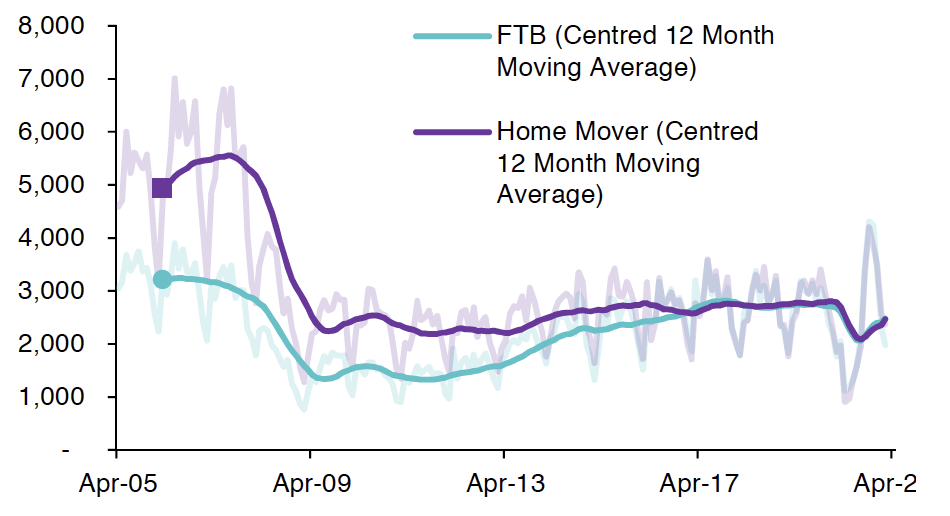
Source: UK Finance
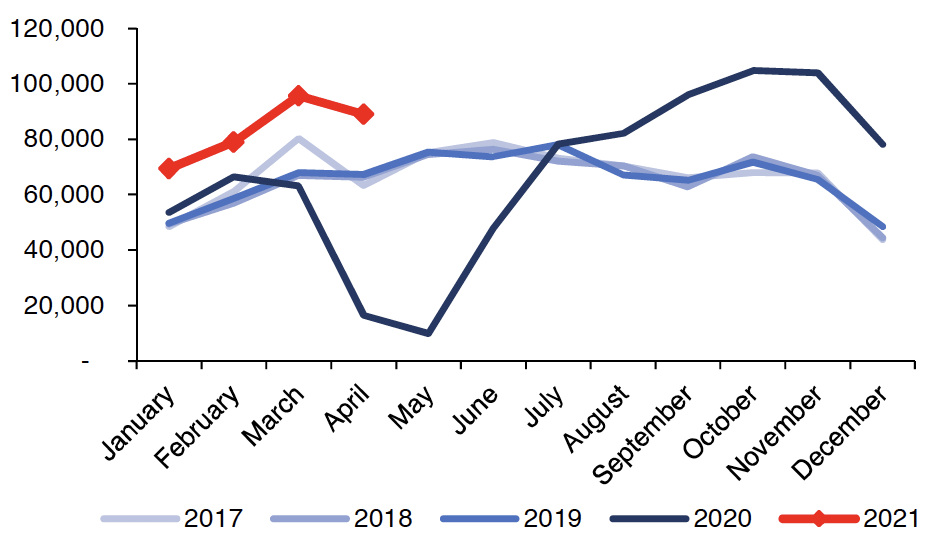
Source: Bank of England
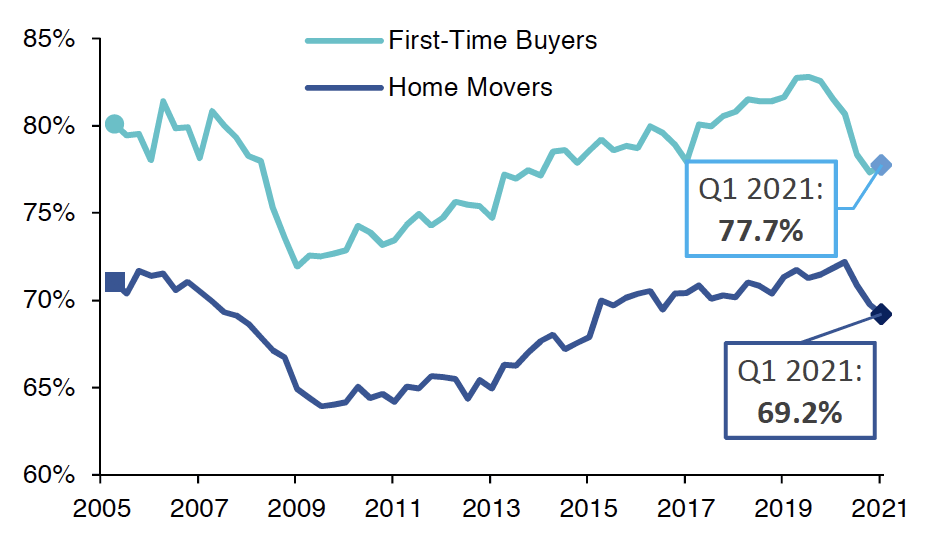
Source: UK Finance
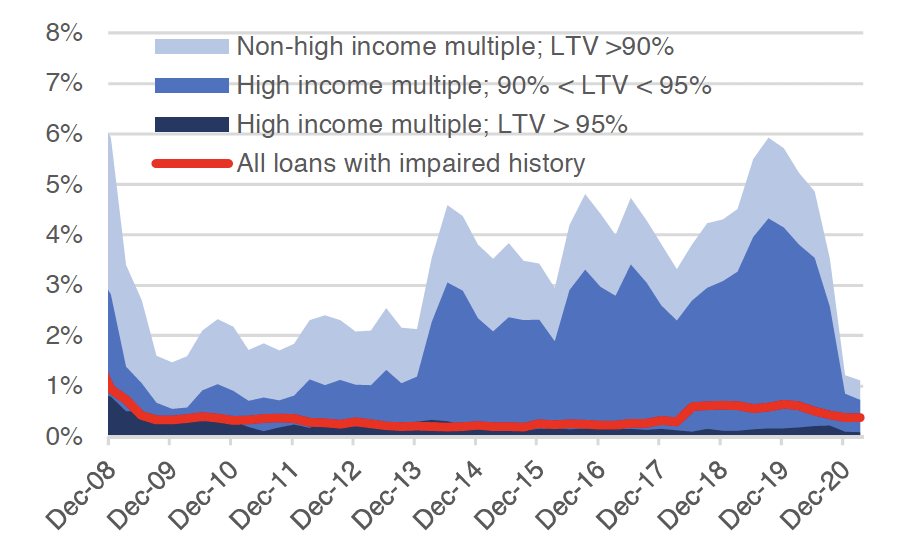
Source: FCA
Interest Rates
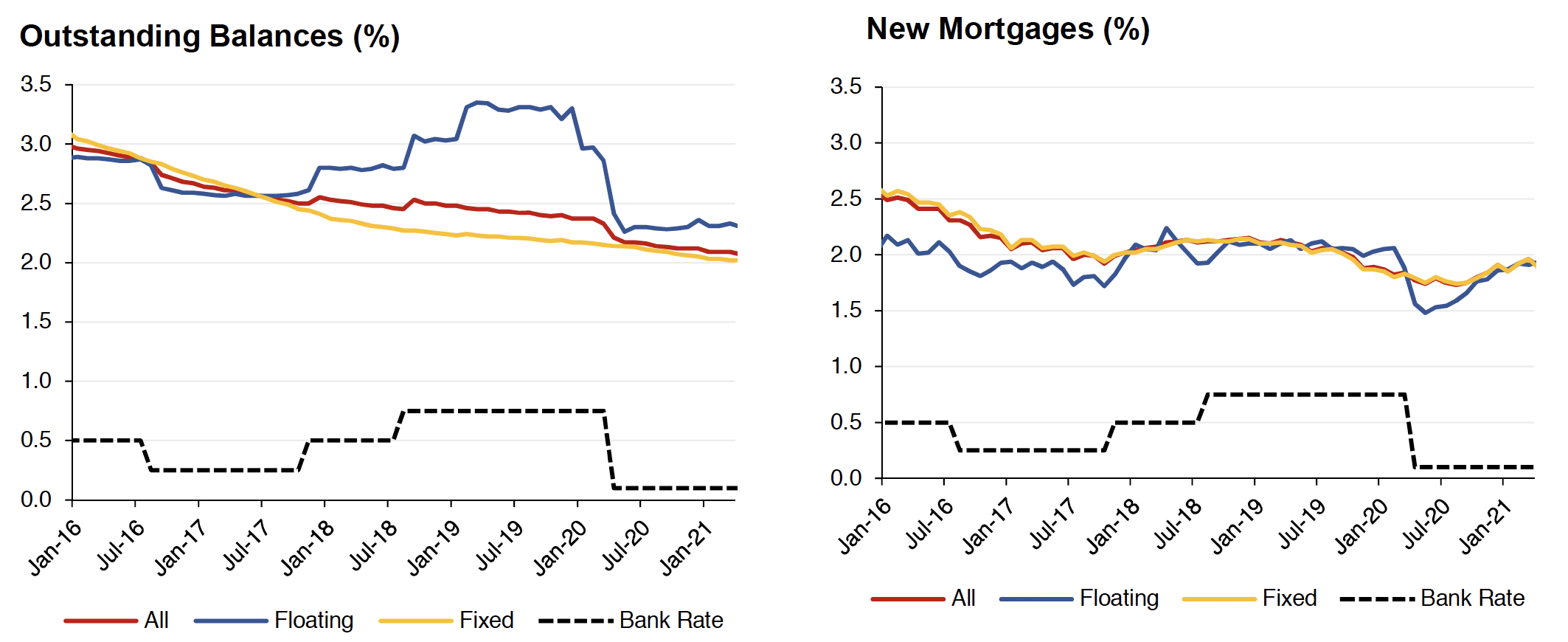
Source: Bank of England
Mortgage Interest Rates
Charts 4.5 & 4.6 show the effective (or average) interest rate on outstanding mortgage balances and new mortgage advances.
In March 2020, Bank Rate was cut by a total of 65 basis points, leaving it at 0.1%. The reduction in Bank Rate has fed through to outstanding variable rate mortgages, with the average interest rate falling from 2.97% in February 2020 to 2.30% in June, before stabilising, with the level remaining at 2.30% in April 2021. The average interest rate on new variable rate mortgages fell from 2.06% in February to 1.53% in June, although it has since increased to 1.94% in April 2021. The average fixed rate on new mortgages has been relatively stable throughout the period of Covid-19, standing at 1.88% in April 2021. (Source: BoE)
The increase in the spread between the average advertised rate on 2 year fixed 90% and 75% LTV mortgages has stabilised recently, as shown in Chart 4.7. In May 2021, the spread stood at 186 basis points, up from 54 basis points in May 2020 but broadly consistent with the spread in December 2020 (189 basis points). It should be noted that Chart 4.7 shows the spread is still relatively narrow in the longer-term context. (Source: BoE)
Chart 4.8 shows that the majority of new mortgage lending (91.9%) is on fixed rates. The share of outstanding mortgages on fixed rates fell from 73.2% in Q4 2019 to 61.6% in Q1 2020, possibly due to borrowers whose fixed rate mortgages reached their end of term either choosing to remain on default variable rates, since these had fallen, or being unable to switch immediately to a new fixed rate mortgage due to lender capacity constraints during lockdown. The share has since increased to 66.2% in Q1 2021. (Source: FCA)
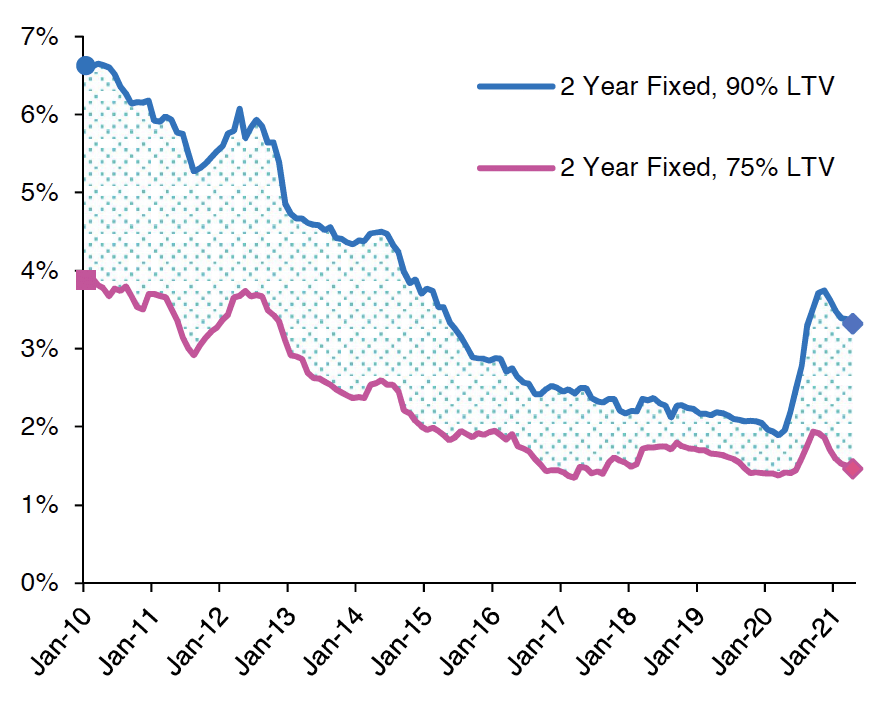
Source: Bank of England
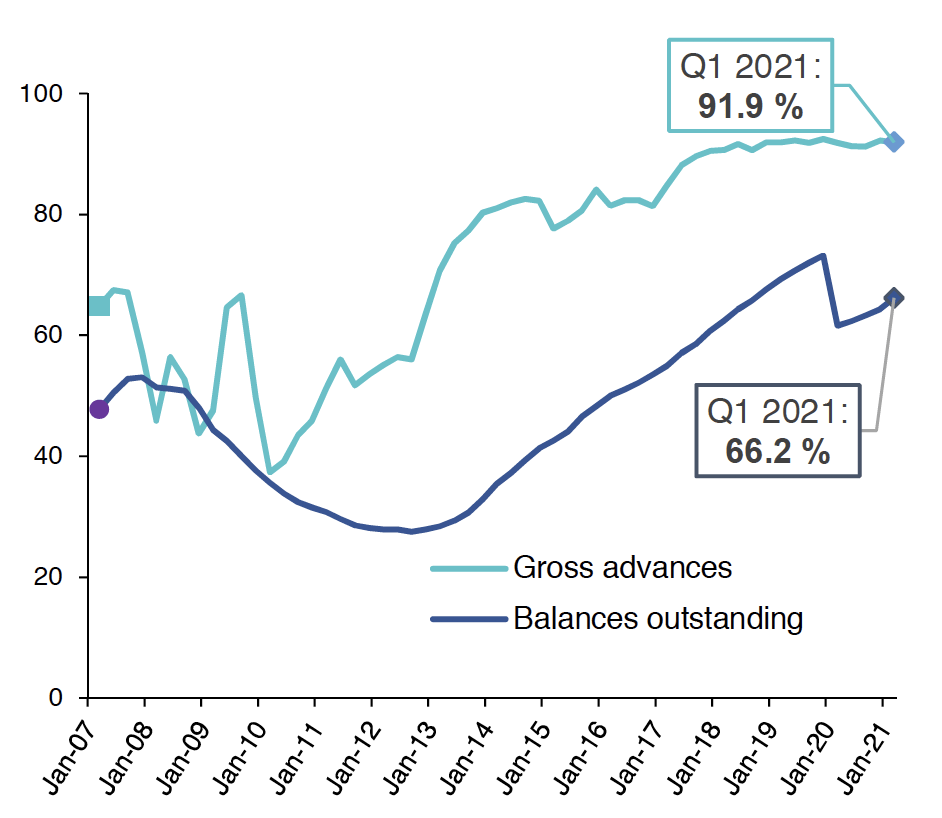
Source: FCA
Arrears
Arrears
Please note: Covid-19 related mortgage payment deferrals are not considered to be formal arrears, and so will not be reflected in the statistics below.
There were 11,363 regulated mortgages that went into arrears across the UK in Q1 2021, a decrease of 21.4% (3,099) on Q1 2020. As shown in Chart 4.9, this is also significantly lower than levels following the 2008 financial crisis, when the number of regulated mortgages that went into arrears peaked at 39,556 in Q4 2008. (Source: FCA)
The share of lenders' outstanding regulated mortgage balances that were in arrears stood at 0.94% at the end of Q1 2021. This has remained broadly stable during the pandemic, with arrears at 0.86% at the end of Q1 2020. Chart 4.10 plots the share of lenders' outstanding balances that were in arrears by degree of severity. Arrears reported in the FCA MLAR data relate only to loans where the amount of actual arrears is 1.5% or more of the borrower's current loan balance.
UK Finance data show that there were 5,970 buy-to-let mortgages in arrears of 2.5% or more of the outstanding balance across the UK in Q1 2021. This is up by an annual 35.1%, although, this growth comes from a low base. This is still low relative to the period of the 2008 financial crisis.
Possessions
There were 183 new regulated mortgage possessions across the UK in Q1 2021, an increase relative to Q4 2020 of 38 (26%) as can be seen in Chart 4.11. However, this is significantly less than pre-pandemic levels, with possessions down by 82% relative to Q4 2019. It can also be seen that regulated and non-regulated possessions moved in a similar direction over the recent period.
Guidance on repossessions
The FCA published finalised guidance for mortgage lenders in March 2021, outlining that repossessions can be enforced from 1 April 2021 but this must be in accordance with FCA guidance and regulatory requirements, which mean that repossessions should only take place as a last resort, if all other reasonable attempts to resolve the situation have failed.
The FCA guidance also recognises that lenders will need to comply with relevant regulatory and legislative requirements in the different jurisdictions across the UK. The Scottish Government extended the ban on repossession of mortgaged properties in areas under level 3 or 4 restrictions until 30 September 2021, subject to review every three weeks (Source: FCA). However, there are no areas in Scotland currently under level 3 or 4 restrictions.
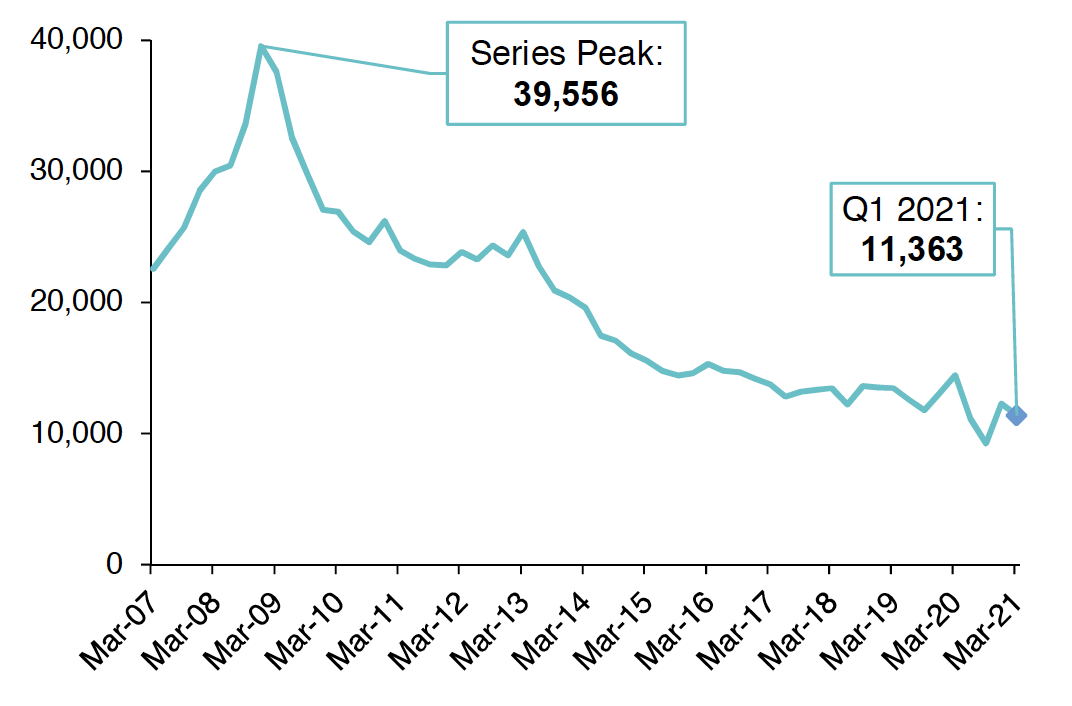
Source: FCA
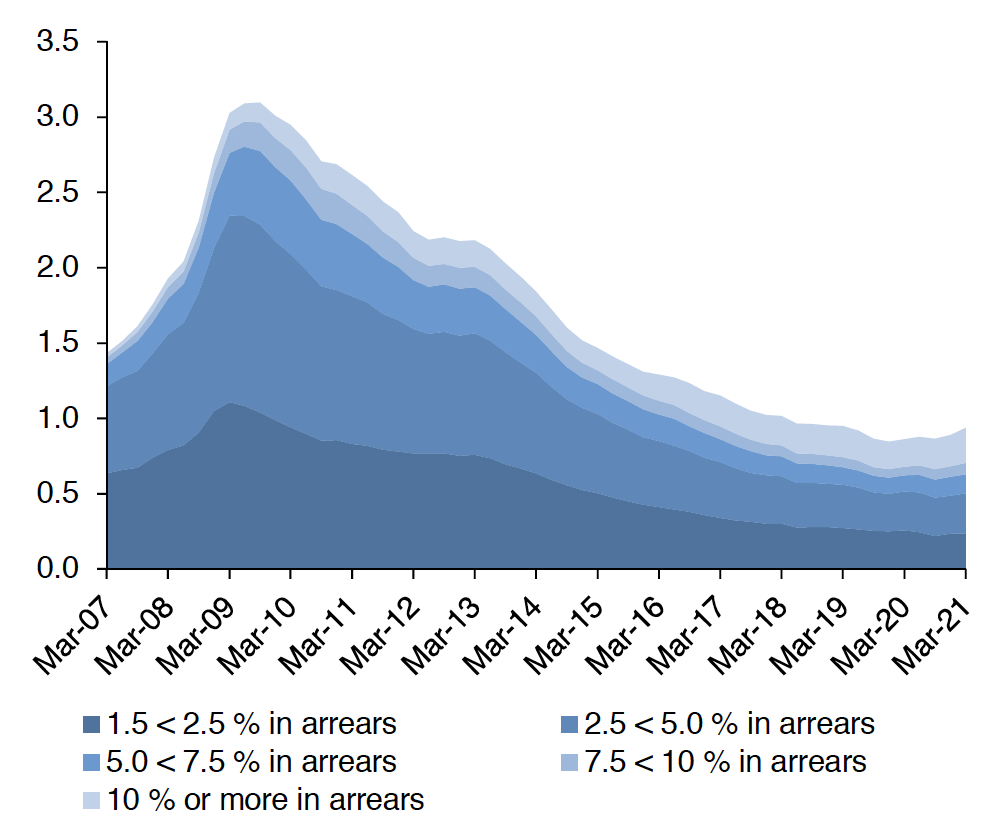
Source: FCA
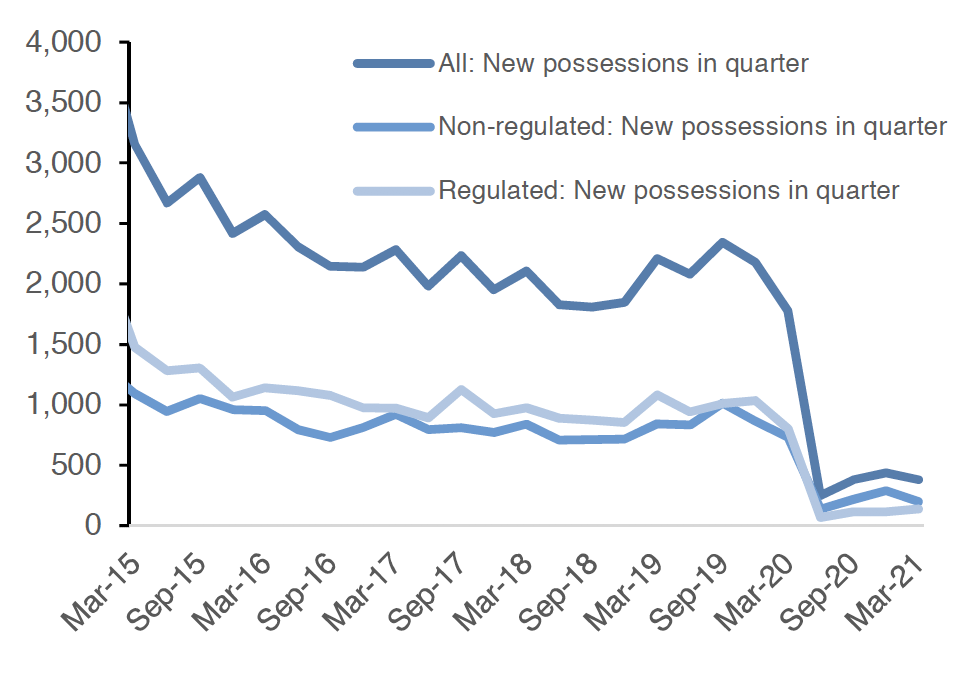
Source: FCA
Residential LBTT; Homelessness

Source: Revenue Scotland
Residential LBTT
There was a reduction in residential LBTT revenue in 2020-21, with residential LBTT liabilities excluding ADS totalling £256.8m, down by 10.6% on 2019-20, and gross ADS liabilities totalling £156.6m, down by 5.9%. This was due to the housing market recovery from Q3 2020 onward being insufficient to offset the lost revenue from the period of housing market restrictions in Q2 2020, as well as from the temporary increase of the zero rate threshold for all buyers to £250K (from £175K for first-time buyers, and £145K for other buyers), which took effect on 15 July 2020 and ended on 31 March 2021.
Residential LBTT revenues excluding ADS rose sharply from £20.8m in February 2021 to £38.3m in March, before falling to £18.3m in April, as transactions were brought forward to benefit from the temporary reduction in LBTT. Revenues then returned to £25.6m in May 2021, which is higher than the £22.9m recorded in May 2019, suggesting the market may have stabilised at pre-covid levels.
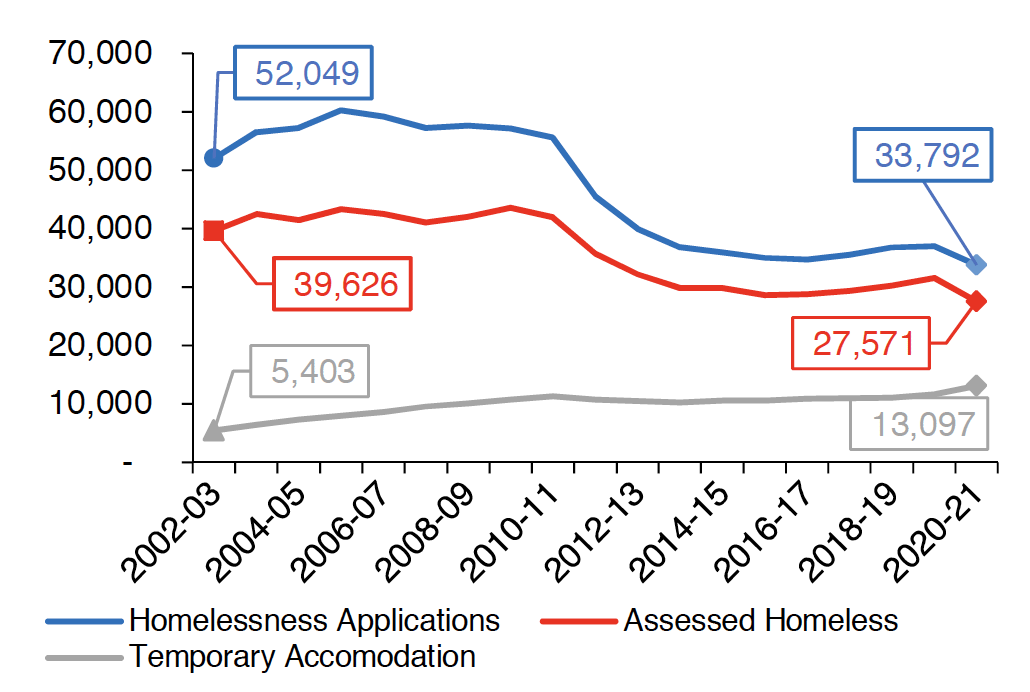
Source: Scottish Government
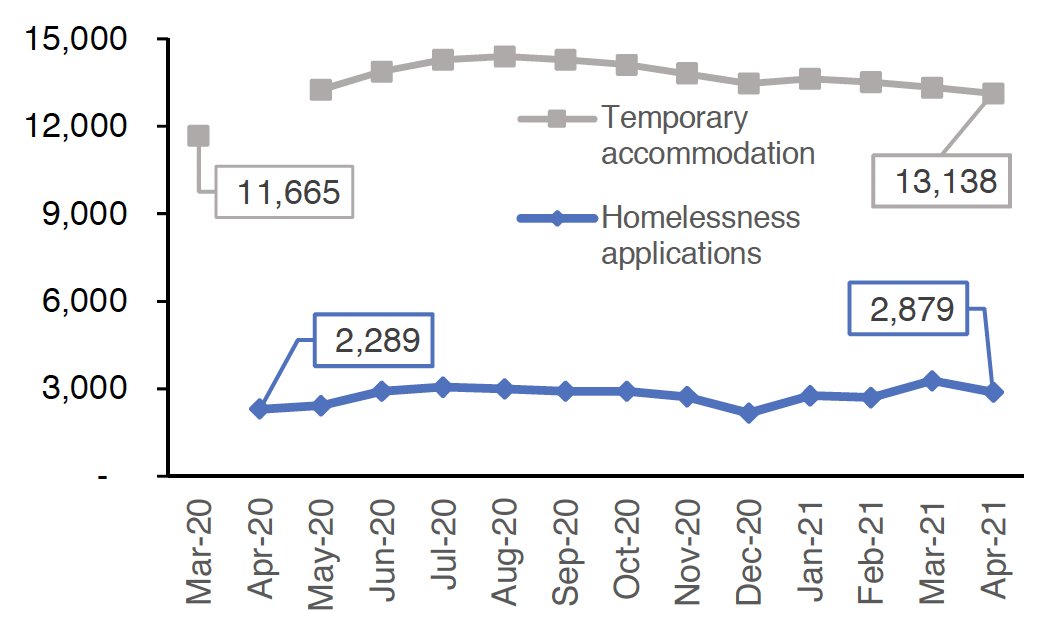
Source: Scottish Government
Homelessness
2020/21 saw 33,792 homelessness applications in Scotland, an annual decrease of 8.8% (-3,251). 27,571 households were assessed as being homeless (including those threatened with homelessness), a reduction relative to 2019/20 of 12.7% (-4,010). This included 30,345 (-15.5%) adults and 11,804 (-26.5%) children. There were 13,097 households in offered temporary accommodation as at 31 March 2021, an annual increase of 12.3% (+1,432).
On a per capita basis, West Dunbartonshire had the highest number of homeless households per 1,000 population (aged 16+) in 2020/21, at 11.9. This compares to a Scottish average of 6.1.
In response to Covid-19 pandemic, the Scottish Government is publishing monthly Management Information on homelessness applications and households in temporary accommodation, although this is not directly comparable to the official homelessness statistics. The monthly data shows that in April 2021 there were 2,879 homelessness applications. The number of households in temporary accommodation peaked at 14,397 at the end of August 2020, but has since fallen to 13,138 at the end of April.
* Note that the monthly temporary accommodation data for April 2020 was missing data from 5 local authorities. Therefore, this data point is suppressed in Chart 5.3. Instead, the figure at the end of March, taken from official statistics, is shown for comparison purposes.
Contact
Email: William.Ellison@gov.scot
There is a problem
Thanks for your feedback